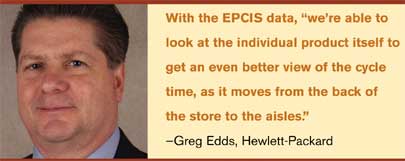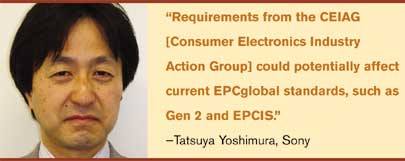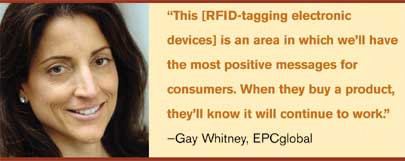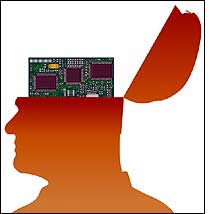When Toshiba Europe started using radio frequency identification technology to track laptop computers at its plant in Regensburg, Germany, the company saw immediate results. Since 2006, the European subsidiary of Japan-based Toshiba has been applying passive RFID tags to the accessory boxes packed with each laptop on the production line, and reading the tags automatically as pallets are moved past RFID interrogators into the warehouse to await shipment to retailers. Previously, it took workers 90 seconds to hand-scan the bar code on each laptop on a pallet. With RFID, the time spent inventorying each pallet has been cut to three seconds.
By speeding up the process, RFID helped Toshiba Europe overcome a bottleneck at the plant and ultimately increase output from 9,500 to 17,300 laptops per day. The cost of scanning each pallet was reduced from 35 cents to 21 cents-saving Toshiba $470,000 last year alone. The RFID initiative also reduced loss and theft of products, and helped Toshiba ensure accuracy of shipments to its customers.
|
|
But the benefits of item-level tagging stop when the pallets leave the warehouse, says Andreas Unterbusch, Toshiba TEC’s RFID project manager. While some European electronics retailers-such as Media Markt and Saturn, both owned by German retail giant Metro-want suppliers to RFID-tag goods, those retail chains are currently reading RFID tags only on cases and pallets. “Toshiba is prepared [for item-level tagging], and this could be used by anybody asking for that,” Unterbusch says. “But nobody is asking for that at the moment.”
The consumer electronics industry is perhaps uniquely suited to item-level tracking. Unlike the consumer packaged goods industry-which produces a lot of low-priced goods, such as toilet paper, detergent and disposable razors-many consumer electronics devices carry high price tags. The products often have a limited shelf life, meaning they can become obsolete quickly due to the development of newer, cheaper products. RFID could help retailers ensure that hot items are on store shelves when prices are high, and help manufacturers manage inventory and better meet demand. From $300 video game consoles to $1,000 computers and $4,000 flat-panel TVs, the value of such items often justifies the cost of item-level RFID tags-even if those tags run $1 or $2 apiece.
In fact, many stakeholders in the consumer electronics industry foresee a day when electronic items will be RFID-tagged during production, tracked through delivery to retailers, tracked in-store to make sure products are stocked on the shelves, and updated with warranty and repair information to provide a virtual pedigree on each device, says Michael Liard, research director for RFID & contactless at ABI Research. Eventually, RFID tags could even help ensure that manufacturers comply with regulatory mandates for disposal of toxic substances (many electronic products contain lead, mercury and other hazardous substances), such as the European Union’s Restriction on Hazardous Substances (RoHS) directive, which went into effect in 2003.
“With RFID technologies implemented in the consumer electronics industry, all players in the industry-manufacturers, logistics service providers, retailers, service and maintenance operators, recycle operators, and most importantly consumers-will have better visibility of products during the product life cycle,” says Tatsuya Yoshimura, Sony’s RFID research and promotion manager, who co-chairs EPCglobal’s Consumer Electronics Industry Action Group (CEIAG). “RFID technology will facilitate collaboration among CE manufacturers and their supply-chain partners, leading to higher profitability and improved productivity.”
EPCglobal’s CEIAG, a group of electronics manufacturers, distributors and retailers and RFID vendors, is now working to bridge the divide between the separate paths that manufacturers and retailers have taken with RFID to date. CEIAG members-including Best Buy, Hewlett-Packard, Hitachi, Nokia, Panasonic, Sony, Toshiba, UPM Raflatac and Wal-Mart-started meeting in August 2007 to begin an expected two-year process aimed at getting industry participants to agree on technology standards to make that vision of life-cycle tracking for computers, TVs and other electronics goods a reality. Several members of the group are pushing for standardization on a passive RFID tag with expanded memory and read/write capability so that product serial numbers and repair and warranty information can be stored on each item, says Gay Whitney, standards director for EPCglobal.
“We’re talking about full product life-cycle management-from the time raw materials are contracted, all the way to when the electronic [device] arrives in the home,” Whitney says. Among the challenges for item-level tagging on electronics is convincing the consumer that there is a benefit to having the tag remain on the item, and convincing manufacturers, distributors and retailers to share data. “It’s still a little futuristic,” Whitney says, “but it’s not that far off.”
Manufacturers Jump Into the Driver’s Seat
Back in 2004, when U.S. consumer electronics retailer Best Buy joined other large retail chains-Wal-Mart and Target in the United States, Tesco in the United Kingdom, and Metro-in asking suppliers to start RFID-tagging electronics at the case and pallet level, many electronics manufacturers only begrudgingly agreed. Suppliers saw the RFID mandates as a one-way street: Retailers would streamline receiving and inventorying processes and realize other internal benefits, while the suppliers would shoulder the cost of the RFID tags with nothing to gain.
Many electronics manufacturers still view RFID as the cost of doing business with certain retail giants. “If you want Wal-Mart’s business, this is what you have to do,” says Mike Morano, RFID project director for Vormittag Associates, which designed an RFID system for appliance maker Haier America and incorporated it into the company’s enterprise resource planning system. Haier America is “not doing anything internal with those RFID tags,” Morano says.
But other electronics manufacturers, including HP, Sony and Toshiba, started experimenting with RFID internally, and they’re finding benefits in several different business cases-from asset and component tracking to improving manufacturing processes, turning out higher-quality products, and reducing loss and theft. Many of these closed-loop applications involve tagging at the item level, and electronics manufacturers would like to extend their RFID tracking to the supply chain to improve sales and reduce counterfeiting.
Asset tracking in electronics ranges from RFID-tagging reels of the tiny components that go onto circuit boards to tagging finished products. NCR’s Automatic Identification and Data Collection (AIDC) Solutions Group has developed an asset-tracking RFID program for an electronics maker that automatically inventories machinery and other assets to help the company meet Sarbanes-Oxley reporting requirements in the United States, which mandate that publicly traded companies provide an accurate accounting of assets. “They must be able to go out and find the assets if they’re being audited, and that can be time-consuming for the organization,” says Donna A. Wright, NCR’s AIDC Solutions Group vice president and general manager, who declined to name the client. “Before we implemented the solution, they had to walk the plant floor….Now they have a visual manufacturing floor with all the lines, and they can tell, cell by cell, where the assets are.”
Last March, Sony Europe, a subsidiary of the Tokyo-based electronics giant, combined RFID tagging of electronic devices with closed-circuit video to help the company cut theft in its shipping processes and settle disputes with retail customers, which often involved whether goods in a shipment had been picked up by a customer from the warehouse. Sony installed the system at its largest European distribution warehouse, in Tilburg, the Netherlands. The company RFID-tags products for shipment, and records the tag IDs on the items at each stage where they are picked and stacked onto pallets. An automated video system records the process and burns RFID data onto the video image. “We scan at three points in the outbound process,” says Sander Merkx, a director with Mieloo & Alexander, the Amsterdam-based systems integrator Sony used on the project. “It reduces untrue claims or disputes with customers diplomatically by providing a lot of transparency. It provides undisputable proof of delivery.”
Sony is considering extending that pilot to delivery of electronic goods at its stores in Europe, according to Yoshimura.
One of the most advanced item-level RFID deployments has been under way at HP’s plant near São Paulo, Brazil, where printers have been RFID-tagged on the base plate with Electronic Product Code tags and tracked throughout production since August 2006. As each printer is being assembled, information about parts, components and tests is added to the memory on the RFID tag. The printers are tracked throughout the manufacturing process and into the warehouse to help HP Brazil increase its visibility, which it uses for analyses such as how long a product stays at any one station on the assembly line and the length of time inventory is stored. Marcelo Pandini, HP Brazil’s manager of RFID and business development, says the data has been helpful in devising ways to cut downtime, increase productivity and perfect order fulfillment. The company estimates that it has reduced its printer inventory in the supply chain by 17 percent and improved its cycle time by 20 percent, driven by greater visibility, process improvements, and quicker detection of slowdowns or stops in the movement of supplies to the assembly line.
Manufacturers are hoping they can extend the benefits from closed-loop item-level tracking of electronics through the supply chain by using the new EPC Information Systems (EPCIS) standard for the exchange of data among supply-chain partners. HP is now receiving data from Wal-Mart from case-level tagging of printers and computers. Since printers and PCs are often shipped as one item per case, that amounts to de facto item-level tagging. Previously, HP received data only on what it shipped, what the retailer received, and what was sold, says Greg Edds, worldwide RFID program lead for HP. With the EPCIS data, “we’re able to see much better the real flow of products,” Edds says. “We’re able to look at the individual product itself to get an even better view of the cycle time, as it moves from the back of the store to the aisles.” The EPCIS data, he says, can be coupled with point-of-sale information to provide another level of granularity to help a manufacturer understand what types of promotions, displays or price points are most effective in selling its electronics.
Retailers Foresee RFID-Enabled Stores
Retailers have made steady progress getting electronics suppliers to comply with RFID-tagging cases and pallets-although Best Buy had to push back its initial target date of May 2007 for full compliance. The initial goal of retailers was to automate receipt of goods, move closer to just-in-time inventory, and help restock shelves on the sales floor to make sure the items that consumers wanted would be there when they wanted them. Now some retailers are realizing that they could also use RFID at the item level inside branch stores to better serve, and sell to, customers.
Retailers around the world have been experimenting with how best to track RFID-tagged electronics. Reliance Retail, one of India’s largest retailers, has been testing RFID to track individual items and cases of electronics and other high-value goods, and recently completed a user initiative between one distribution center and one Reliance Retail store. The results are still under evaluation.
In some recent initiatives, retailers such as Best Buy have moved away from placing fixed interrogators throughout test stores and opted for the less costly and more flexible solution of equipping salesclerks with handheld readers to help locate products, restock store shelves and conduct quicker inventories. Accenture RFID lead Paul Schmidt, who has been involved with some of these tests, points out that a consumer “may pick up a case and walk down two aisles and put down what they had picked up previously. Now it’s in the wrong place. But inventory shows that it’s in stock. RFID can make sure things are in the correct position.”
In an interview with RFID Journal.com in June, Best Buy CIO Bob Willett said the 750-store chain envisions using RFID in a “store of the future” that will have automated checkout lines that can read RFID tags on items and process payments. Once technology costs come down, Willett foresees a scenario in which customers could more easily locate an RFID-tagged item in the store, pay for it with a credit card at an automated station, and request that the item be home-delivered or prepared for pickup at the front of the store-all without a cashier’s assistance. “Could you imagine how many people would be relieved from working on checkout to help other customers in the store with the products? Really, this is all about enhancing the customer’s experience,” he says.
Forging a Path to the Future
The question that the consumer electronics industry is now working to answer is whether one RFID tag placed on a product during manufacture can deliver even more benefits. Based on a series of 2006 RFID user initiatives sponsored by the Japan RFID Consortium for Consumer Electronics (JRCCE), which is funded by Japan’s Ministry of Economy, Trade and Industry, the answer is a resounding yes.
Hitachi, one manufacturer that participated in the initiatives, applied RFID labels to removable “guaranty” cards on boxes for flat-panel TVs, DVD recorders and computer hard drives at a manufacturing site in Japan. The RFID tags contained each product’s EPC number. The tags were read when goods were being stored in the warehouse and again when they were shipped. When purchased products were brought to participating retailers for repairs, the RFID tag was read, and information about the guaranty-or warranty-terms could be called up on a computer screen. The salesclerk could also check to see if a product had been recalled. Repair information was added in the database, which the customer could access online using EPCIS data. The tags were also read to confirm the customer’s receipt of the repaired product.
The JRCCE initiatives found that RFID tracking benefited the consumer, retailer and manufacturer alike. For the consumer, the repair time was shortened, and access to current information about the status of the repair lessened anxiety. For the retailer conducting repairs, RFID and the accompanying repair history helped pinpoint what needed to be fixed the soonest, and it helped track devices through the process so that goods would not get lost. For the manufacturer, having information about warranties and recalls tied to the chip allowed faster verification of warranty coverage and limited the scope of recalled products. A JRCCE presentation said future tests should put the RFID tag on the electronic device itself, expanding the amount of memory on the RFID chip and verifying results with smaller manufacturers and repair shops.
To turn the “life-cycle tracking” vision of the future into a reality, retailers and manufacturers need to come to terms with what data they will share. “Do companies want to share everything about how much time it takes to manufacture products? Probably not,” says EPCglobal’s Whitney. “But they may want to share information about when a product left their possession.” In addition, some third-party players-such as logistics companies and distributors-may be partners to the data capture and exchange in the electronics supply chain.
The data exchange issue is driving the CEIAG to hammer out standards, which it expects to complete by summer 2009, so that RFID will be a win-win technology for all concerned. While EPCglobal has formed action groups in other industry verticals, the consumer electronics group is breaking some new ground. “The initial work of the CEIAG is focused on developing high-level business processes, or business process scenarios and use cases, for specific CE industry needs,” says Sony’s Yoshimura. “The group will then carry out a requirements-gathering exercise, which could lead to the amendment of existing EPCglobal standards. Requirements from the CEIAG that could potentially affect current EPCglobal standards, such as Gen 2 and EPCIS, include much larger tag data memory, long-life tags, multiple rewrites, tagging inside an item, data security features, and multiple tags on the same item.”
Manufacturers and retailers are aware that consumers may have privacy concerns about RFID tags being placed on electronic devices themselves, as opposed to being affixed to boxes that they can throw out. But consumers who buy electronics that require maintenance may see benefits in having repair and warranty information stored on the device. The stored data, as exemplified in the Japanese tests, could speed up repairs, help pinpoint quality issues and facilitate easier recalls. “This is an area in which we’ll have the most positive messages for consumers,” Whitney says. “When they buy a product, they’ll know it will continue to work.”
For now, manufacturers and retailers need to understand that the gains they have seen individually from closed-loop RFID deployments or case and pallet tagging can be magnified if they standardize on item-level tracking in the open supply chain. “The industry has worked hard, particularly in the passive UHF realm, to increase read accuracy and speed,” says ABI Research’s Liard. “Now that we effectively know how to capture RFID data, we have to figure out how we can leverage RFID data through the supply chain.”
Circuit Boards Get Smarter
Inside most electronic products is a printed-circuit board populated with hundreds of tiny components. Machines mounted with special feeders and robotic arms remove components from large reels of tape and place them onto the circuit board plate. If the components aren’t placed properly and in a precise sequence, the device won’t power up or function as it should. Currently, workers have to scan the bar codes on the reels, feeders and machines to make sure all three match.
“Every time you’re changing from product A to product B, you maybe need to change a few hundred reels on a line,” says François Monette, co-president, sales and marketing, for Cogiscan, a Quebec-based technology supplier. “This is very time-consuming to scan each reel with a bar code.”
To help remedy the problem, Cogiscan developed the “smart feeder,” which uses RFID to automatically verify that the right feeder is being put on the right machine. Companies such as Fuji, Juki, Panasonic and Siemens have been using the smart feeder for several years. In late 2007, Cogiscan introduced the “smart reel,” to reduce the time it takes to find the right reels and load them onto the proper machines. The RFID application, developed with Fuji, Juki and Siemens, is being reviewed by several companies.
Each reel is RFID-tagged, and that tag is read and verified by an RFID interrogator situated on each feeder. “If you put RFID on the reels, it reduces the setup time and increases overall equipment utilization,” Monette says. “You also make it more error-proof.”
The smart reel is the latest RFID application developed by Cogiscan to automate the production of circuit boards. In 2001, the company introduced an RFID product that calculates the limited floor life of components that are moisture-sensitive. Such components can develop cracks that impede the reliability of finished products. When reels or trays containing moisture-sensitive components are removed from dry bags, they are RFID-tagged.
The reels or trays are scanned every time they are moved among locations or machines. Cogiscan’s software application tracks the history of exposure time and monitors the remaining floor life of the components, triggering warnings and alarms to production operators if that lifetime is exceeded. “Your finished product is produced at a better quality and lower cost,” Monette says.





